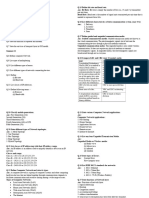0% found this document useful (0 votes)
129 views7 pagesDCN Important Questions
The document outlines important questions from various chapters related to data communication and networking, including short answer and long answer questions. Topics covered include data communication systems, types of networks, transmission media, error detection techniques, the OSI model, and network topologies. Each chapter contains a mix of conceptual and technical questions aimed at assessing understanding of networking principles.
Uploaded by
Swapnil GhadageCopyright
© © All Rights Reserved
We take content rights seriously. If you suspect this is your content, claim it here.
Available Formats
Download as DOCX, PDF, TXT or read online on Scribd
0% found this document useful (0 votes)
129 views7 pagesDCN Important Questions
The document outlines important questions from various chapters related to data communication and networking, including short answer and long answer questions. Topics covered include data communication systems, types of networks, transmission media, error detection techniques, the OSI model, and network topologies. Each chapter contains a mix of conceptual and technical questions aimed at assessing understanding of networking principles.
Uploaded by
Swapnil GhadageCopyright
© © All Rights Reserved
We take content rights seriously. If you suspect this is your content, claim it here.
Available Formats
Download as DOCX, PDF, TXT or read online on Scribd
/ 7























































































